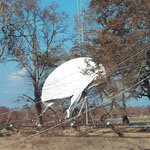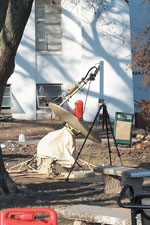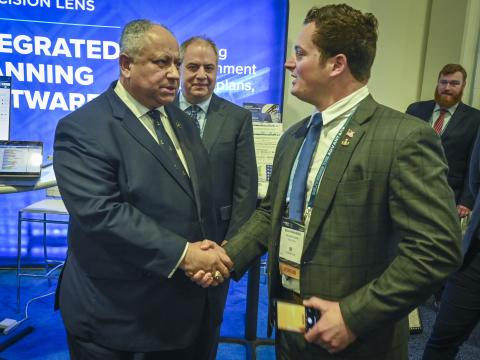Coordinating Disaster Relief Requires a National Plan
Numerous interoperability efforts are underway, but an overarching, unifying concept is missing. 
Typical communications infrastructure destruction caused by hurricanes Katrina and Rita led the U.S. Defense Department and the U.S. Northern Command to deploy military communications systems to the region.
The
In the wake of hurricanes Katrina and Rita, public safety leaders at all levels across the country became reacquainted with the challenge of effective command and control of relief missions and of first responders following a disaster. Similar lessons were learned following the 1993 attack on the
Hurricane Katrina showed that the loss of communications infrastructure and power facilities over a large area presents challenges beyond the ability of local and state governments to address. The catastrophe extended over multiple states and Federal Emergency Management Agency (FEMA) regions. As a result, local and state governments requested the federal government to assist by providing coordination and logistical support to achieve the swift restoration or replacement of public safety communications infrastructure. Information sharing among state and local authorities was problematic because of lack of interoperability. The absence of these critical communications capabilities left government leaders with inadequate situational awareness to provide effective command and control of the overall response effort.
Each of the autonomous public safety authorities at department, agency, state, county and local government levels has its own resources allocated to address this problem, and many of these organizations have developed firm positions that their approach is the best solution. The result is a hodgepodge of many stovepipe systems with no common standards and little interoperability. Until the interoperability problem is solved, the potential exists to relive and relearn the problems experienced during Hurricane Katrina.
Building consensus on possible solutions is difficult. At the local level, many in the public safety and emergency response communities are resistant to alternative proposals. In addition, boundaries of departments, agencies and governments as well as political differences between adjacent communities contribute to the dilemma and result in the development of closed system solutions.
Although numerous interoperability efforts are underway at national, state and local agencies, no overarching, unifying concept exists to tie this work together. As a result, the competition for resources and the compartmented solutions create a struggle. While the National Response Plan (NRP) guides the federal response for disaster relief operations, it does not provide a comprehensive communications strategy or overall architecture to enable top-to-bottom effective and interoperable communications.
Development of a comprehensive and unifying communications strategy shared among all homeland security stakeholders is critical to the success of future disaster relief operations. Common standards would enable homeland security providers and those involved in homeland defense to deploy communications capabilities cooperatively to restore or improve communications in an affected area. Such a unifying concept requires a national-level partnership among federal, state and local homeland security partners. Key players in such a partnership include the U.S. Department of Homeland Security, the U.S. Defense Department and Department of Justice, the National Telecommunications and Information Administration, the National Guard Bureau, the states as well as commercial providers in the telecommunications sector.
A review of communications successes in support of Hurricane Katrina relief efforts shows that cell phone and land mobile radio (LMR) technology emerged as the strongest candidates to meet the need for an interoperable communications medium. Whether in the federal, state or local arena, all homeland security stakeholders use cellular technologies and LMRs in some facet of their operations. Cellular technology is ubiquitous in its penetration of the user community and provides the means to enable voice, video and data communications for all levels of governments and agencies. The simplicity of cellular devices also minimizes training requirements. Linking cellular systems to LMR systems for emergency operations leverages the capabilities of both systems and facilitates information exchange between first responders and crisis managers.
The most significant challenge to this solution is the probability that the existing cellular and LMR infrastructure would be inoperative as a result of damage or loss of power. This problem can be solved in the short term with the use of rapidly deployable, generator-powered cellular base stations with LMR interfaces. These cellular base stations could be prepositioned with regionally focused response capabilities for the federal, state or local level and could be deployed immediately when needed. Use of these base stations in multiple configurations, such as enclosed in transit cases or mounted on vehicles, aircraft or hastily established towers, would enable rapid delivery of communications assets to first responders in and around the incident site.
The proposal for cellular technology as the interoperability communications medium of choice does not eliminate other communications problems or the need for other means of communication. Equipment still will be necessary to bridge the frequency gap between incompatible civilian radio networks as well as to link those networks to military radios, whether those radios belong to the National Guard or to active-duty troops. A significant challenge exists on the spectrum/frequency front to consolidate enough dedicated spectrum to support an overarching strategy for public safety radio standards and capabilities at the local, state and national levels.
As part of a national disaster relief architecture, the government should require commercial cell phone carriers to provide emergency access into their teleports. A private emergency area code that all responders could use and fixed telephone numbers for the agencies involved are necessary and could eliminate the need to create telephone books on the fly. This emergency response network would have clearly identified standards for interfaces to commercial cellular and telephone infrastructures and to LMR networks. Such a policy would codify many of the processes that occurred during hurricanes Katrina and Rita relief and should be championed by the Defense Department.
Within such an emergency network, when a disaster occurs, any of the affected emergency operations centers or agencies could employ their contingency satellite systems to communicate with a commercial teleport outside of the affected area, restoring communications for first responders and emergency personnel. Interface equipment that connects to the appropriate LMR networks could provide access to the first responders who have only push-to-talk radios. These efforts would provide a cushion of time to bring in relay devices, new towers and other resources while providing some measure of quick emergency communications. A cellular code division multiple access (CDMA) or other commercial standard base station could be connected to the satellite network. Then communicators immediately would have access to telephones and the Internet, assuming laptops or AirCards also are made available. The U.S. Northern Command currently has one of these systems, and it was the model for six others purchased by FEMA.
At the national level, the telecommunications industry should develop a strategy that works similarly to that of the Civil Reserve Air Fleet (CRAF). Under this CRAF model, commercial cellular providers would be required, as part of their spectrum/frequency licensing agreements, to maintain the resources to supply rapidly deployable cellular base stations, offering perhaps enough regional coverage for a few hundred square miles. In times of national or regional emergency, commercial carriers would be required to deploy such capabilities and to enable priority access to first responders and emergency response operations centers at the local, state and national levels. This technique also could be used to provide government agencies and first responders with temporary, rapid access to industry-controlled frequency and spectrum resources necessary to operate government-owned cellular base stations.
 |
| Satellite reach-back for voice over Internet protocol telephones, data and videoconferencing was established by a South Carolina National Guard communications team at Cameron Parish Courthouse, Louisiana. |
The concept of using cellular technology as the interoperability communications tool of choice must be addressed at the national level as part of an all-inclusive communications strategy to support the NRP. A comprehensive national strategy, a plan to ensure implementation of that strategy and a supporting national emergency communications architecture are critical to the success of future disaster relief efforts. Attaining compliance by state and local governments may require incentives. This could entail making interoperability standards part of the grants given for homeland security programs and initiatives.
The NRP communications architecture should be developed to address the issues of first responder communications and interoperability and how federal, state and local governments and the Defense Department would participate in this network. Formal agreements and laws will be necessary to make commercial carriers part of the solution. This architecture must leverage commercial, state, federal and Defense Department assets to form a standardized emergency network. The architecture should identify assets, procedures and standards for interoperability and should require monitoring and enforcement by the Defense Department and other government agencies.
Also, as part of this architecture, the government should require commercial telephone and cellular carriers to provide emergency access to their networks as part of the national emergency/first responder network. This emergency response network will have clearly identified standards for interfaces with commercial cellular and telephone infrastructures, emergency operations centers from the federal to first responder levels, and LMR networks.
Identifying and establishing a national family of standards to achieve interoperability would codify solutions to many of the problems experienced during Hurricane Katrina. However, the way ahead is not easy, nor is it free of obstacles. Cultural, political and commercial aspects of the challenge will make it difficult to build consensus. Bold steps are required to harness the technology that currently exists and to put these national communications challenges to the forefront of issues that need to be addressed and resourced. Prolonged study, discussion and debate will delay the interoperability required to save and sustain lives and to maintain confidence in the government.
Clearly and quickly, the Defense Department and the Department of Homeland Security should identify and publish the standards to be used for emergency and first responder communications. They must procure items that meet those standards through control of federal grants. The Federal Communications Commission should review telecommunications licensing procedures in the continental
Col. James P. Kohlmann, USA, is the science and technology adviser at the Command Control Systems Directorate of the North American Aerospace Command and the
Col. Keith H. Snook,
Photographs by Col. James P. Kohlmann,



